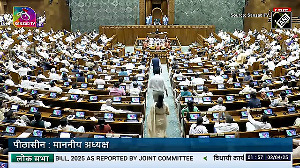The Government of India introduced new tax forms on May 16. Eight new Income Tax returns now replace the old Saral forms. Of these, four are for individuals and Hindu Undivided Families (HUFs), while the rest are for firms, companies and charitable, religious political and non-profit organisations.
The forms bring with them several innovations. For example, the new forms are annexe-less and you will no longer have to submit documents as annexures. You just need to fill in information on the form.
Also, providing details of cash flow, a serious concern to most of us, has been deleted from the new form.
Tax expert Sandeep Shanbhag is on the whole enthusiastic about the new forms. He says the new format makes tax evasion more difficult and brings in greater transparency. He also lauds the new AIR model of only submitting information regarding credit cards, property, RBI bonds, etc.
Shanbhag points out that the earlier two-page Saral form needed separate substantiation via documentation. In the new forms, you need to submit just the information. On the flip side, the new forms have a universal structure and format for different individuals, businesses; and institutions and structuring the profit & loss sheet according to this format will be difficult.
Most forms are very lengthy -- about 12 pages long -- except for the ITR1, which is applicable only to a limited number of individuals. This may not go down well with the taxpayers.
Tax expert Subhash Lakhotia feels the new form has not made things easier or simpler for the taxpayer. It is more complex than the previous Form 2D or Saral form. "The worst part about this form is that the taxpayer has to mention all the AIR transactions. Giving details about all the sales and purchases, be it property or RBI bonds, is mandatory. One has to give details of all the cash withdrawals, too."
Lakhotia feels there was no need to change the previous form; and the government will not achieve anything special with the new forms.
He suggests, "Filing the new income tax form is compulsory. Therefore, even if the form is not available at the Income Tax office, please download it from the Income Tax Department web site. Get a photocopy of the same and use the requisite form applicable to you."
You must fill all your details because submitting an incomplete form is an invalid return.
You also need to fill in transactions reported in these AIRs in the return form. These will be matched with details provided by banks, and will generate increased compliance.
Chartered accountant Ameet Patel has mixed feelings about the whole exercise. "The number of forms has increased. People will find it difficult to identify which form is applicable to them and will need expert advice. This just complicates things. Also these forms are valid specifically for the year 2007-08, which means that the format may change again next year. They had changed last year. It shows the government is not sure of its reforms."
Patel says this move was apparently to accelerate the e-filing process and make it compulsory for everyone, not just for companies and firms, as is the case now. "While e-filing is a laudable effort and no one is debating its benefits, these forms are not indicative of a smooth transition. People will now have to depend on professionals like tax practitioners, chartered accountants or tax preparers."
ALSO READ:
- Form 16 need not be submitted
- Zero tax on income of Rs 11.20 lakh?
- All these incomes are tax-free for FY 2007-08
- Tax exemptions to go eventually, says FM
- How Budget affects your tax
- Tax tips for harried senior citizens
For more on financial planning, log on to click here.






 © 2025
© 2025